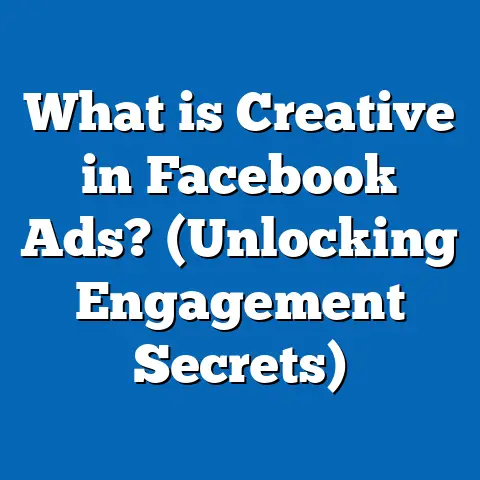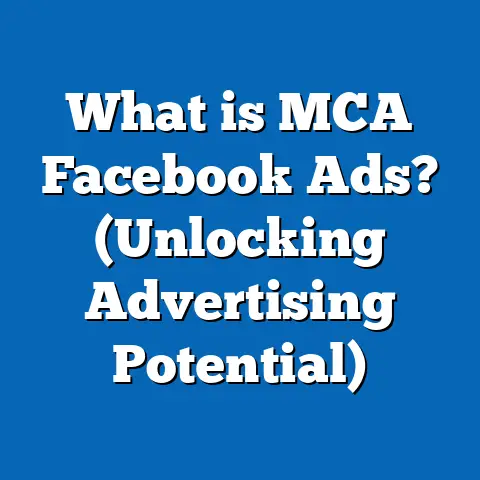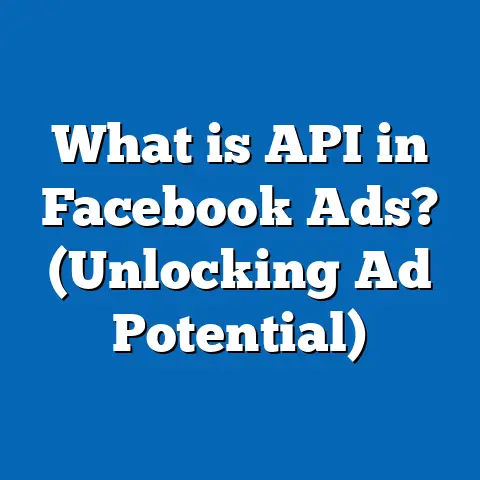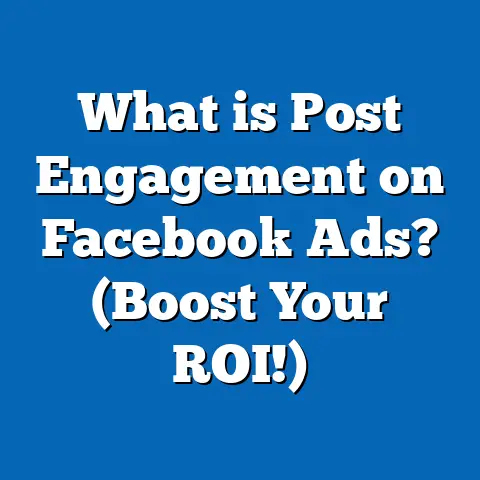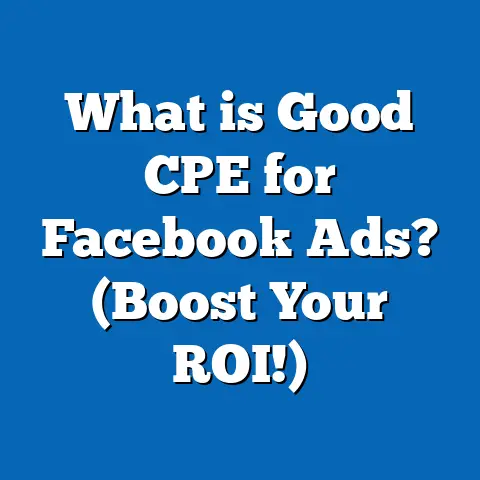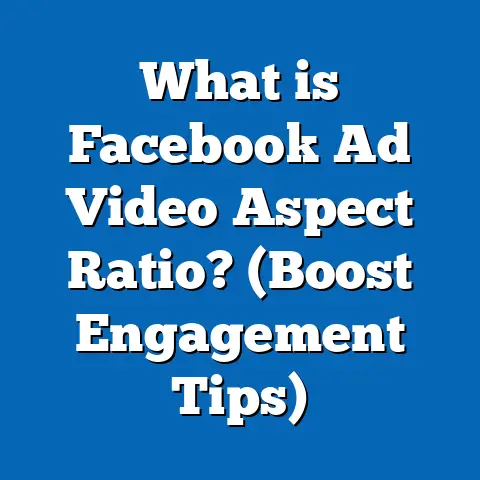What is a Good Starting Budget for Facebook Ads? (Expert Tips)
What is a Good Starting Budget for Facebook Ads? (Expert Tips)
Have you ever wondered how much you should realistically spend to see meaningful results from Facebook advertising? Whether you’re a small business owner or a marketing professional, setting the right starting budget for Facebook Ads is crucial for maximizing return on investment (ROI) and avoiding costly mistakes. This guide will walk you through everything you need to know—from understanding Facebook’s ad ecosystem and cost structures to expert tips on budgeting based on your goals and industry.
Why Setting the Right Facebook Ads Budget Matters
Facebook advertising has transformed digital marketing by offering businesses the ability to reach highly targeted audiences at scale. However, this power can be a double-edged sword without the right budgeting strategy.
The Cost of Overspending
An inflated budget without clear targeting or optimization can result in wasted ad spend. For example, a business might burn through hundreds or thousands of dollars per day without seeing conversions if the ads are not resonating with the right audience or if the campaign objective isn’t aligned with business goals.
The Risk of Underspending
On the flip side, too small a budget can limit exposure and data gathering. Facebook’s machine learning algorithms need sufficient data points to optimize ad delivery effectively. If your budget is too low, your ads may never exit the “learning phase,” leading to suboptimal results.
Striking the Right Balance
A well-balanced budget allows for enough data collection and testing while preventing excessive spending during early campaign phases. This balance helps marketers iterate quickly and scale successful ads efficiently.
Understanding Facebook Ads Costs: Key Concepts
To set an effective starting budget, it’s important to understand how Facebook charges advertisers and what influences these costs.
Facebook’s Auction-Based System
Facebook ads operate on an auction system where advertisers bid for ad placements competing against others targeting similar audiences. Your bid, along with ad quality and estimated action rates, determines your ad’s placement and cost.
Key Pricing Models
- Cost Per Click (CPC): You pay each time someone clicks your ad. This model suits campaigns focused on driving traffic or direct actions.
- Cost Per Mille (CPM): You pay per 1,000 impressions (ad views). Ideal for brand awareness campaigns aiming for maximum reach.
- Cost Per Acquisition (CPA): You pay when a specific action occurs (sale, lead). This is common in conversion campaigns.
- Cost Per Like/Engagement: Used in campaigns focused on page growth or post engagement.
Each model suits different objectives and will affect your budget allocation.
What Influences Facebook Ad Costs?
Several factors impact how much you’ll pay for Facebook ads:
- Industry Competition Highly competitive industries like finance, insurance, legal services, and e-commerce often see higher CPCs. For example, finance-related ads may have CPCs of $3 or more compared to less competitive sectors like arts or non-profits with CPCs under $1.
- Audience Size and Targeting Specificity Narrow targeting increases competition for the limited audience pool, often increasing costs. Broad audiences tend to have lower CPCs but may be less relevant.
- Ad Quality and Relevance Score Facebook rewards engaging ads with lower costs. Ads with high relevance scores (now called “quality ranking”) tend to perform better and cost less per result.
- Placement Costs vary by where ads appear: News Feed ads generally cost more than those in right column or stories placements.
- Seasonality During peak periods (e.g., Black Friday, Christmas), costs rise due to increased advertiser competition.
- Device Type Mobile ads often have different costs compared to desktop ads based on user behavior.
Average Cost Benchmarks for 2024
| Metric | Average Cost | Notes |
|---|---|---|
| CPC (Cost Per Click) | $0.50 – $2.00 | Varies by industry and location |
| CPM (Cost Per 1,000 Impressions) | $5.00 – $15.00 | Brand awareness campaigns typically use CPM |
| CPA (Cost Per Acquisition) | $10.00 – $50.00+ | Depends heavily on conversion complexity |
These benchmarks offer a starting point but expect variation based on your niche and campaign specifics.
How to Determine Your Starting Budget: Step-by-Step Approach
Step 1: Define Your Campaign Objective Clearly
Facebook offers multiple campaign objectives that shape how your budget will be spent:
- Awareness: Brand awareness or reach campaigns focus on getting your ad seen by as many people as possible.
- Consideration: Traffic, engagement, video views, lead generation goals fall here.
- Conversion: Sales, app installs, catalog sales campaigns aim at driving direct actions.
Choosing the right objective is fundamental because it affects bidding strategy and ideal budget size.
Step 2: Understand Your Customer Lifetime Value (CLV)
Knowing how much profit an average customer generates over their lifetime helps you set an acquisition cost ceiling.
- If your average customer yields $500 in profit and you aim for a 3x return on ad spend (ROAS), you can afford to spend up to $166 per acquisition.
- If your product is low margin ($50 profit), you must keep CPA much lower.
This calculation prevents overspending on ads relative to business profitability.
Step 3: Start Small with Testing Budgets
Facebook recommends starting with a daily budget between $5-$20 when testing new ads.
- This amount collects enough impressions and clicks to evaluate ad performance over 7-14 days.
- Testing multiple audiences, creatives, and placements during this phase reduces risk before scaling.
Step 4: Calculate Monthly Budget Based on Business Size
| Business Size | Recommended Starting Budget (Monthly) | Rationale |
|---|---|---|
| Small Business (<$1M revenue) | $300 – $1,000 | Allows testing & modest scaling |
| Medium Business ($1M-$10M) | $1,000 – $5,000 | Enables robust testing & multiple campaigns |
| Large Business (>$10M) | $5,000+ | Supports complex strategies & large reach |
Your budget should be flexible based on campaign results and business goals.
Deep Dive: How Different Campaign Objectives Affect Budgeting
Brand Awareness Campaigns
- Goal: Maximize reach and impressions.
- Cost Model: CPM.
- Budgeting Tip: Focus on broad audiences; start with $10-$20/day.
- Key Metric: Cost per 1,000 impressions; aim for CPM under $10.
- Example: A local restaurant promoting new menu items may start with $15/day focused on nearby residents.
Traffic Campaigns
- Goal: Drive users to website or landing page.
- Cost Model: CPC.
- Budgeting Tip: Test multiple creatives; start with $15-$25/day.
- Key Metric: CPC; aim for under $1 in most industries.
- Example: An online course provider targeting interest-based groups begins at $20/day testing two different ad copies.
Lead Generation Campaigns
- Goal: Collect contact info for follow-up.
- Cost Model: CPA or CPL.
- Budgeting Tip: Start with $20-$30/day focused on warm audiences.
- Key Metric: Cost per lead; industry average varies from $10-$40.
- Example: A real estate agent runs lead gen ads with an initial budget of $25/day targeting first-time homebuyers.
Conversion Campaigns
- Goal: Drive sales or specific actions.
- Cost Model: CPA.
- Budgeting Tip: Minimum daily budget should be enough to generate 50+ conversions/month for stable data (~$50/day).
- Key Metric: CPA; depends on product price and margins.
- Example: A subscription box company invests $50/day optimizing towards purchases via pixel tracking.
Case Study 1: Small E-commerce Business Starting Budget Success
Business: Boutique skincare brand
Objective: Increase online sales
Initial Budget: $10/day (~$300/month)
Approach:
- Tested three different target audiences over two weeks: lookalike audience based on past customers, interest-based targeting (beauty enthusiasts), and retargeting website visitors.
- Monitored engagement metrics to identify winning creatives.
- Increased daily budget gradually to $25/day focusing on best-performing audience after initial test phase.
Results:
- CPC dropped from $1.50 initially to $0.75 after refining targeting.
- ROAS reached 400% within two months.
- Monthly online sales increased by 30%.
This demonstrates how starting small with a well-planned test can enable efficient scaling.
Case Study 2: Medium-Sized SaaS Company Budget Strategy
Business: SaaS productivity tool
Objective: Generate trial signups
Initial Monthly Budget: $3,000
Strategy:
- Allocated 40% of budget to cold traffic campaigns targeting job titles in relevant industries.
- Used 30% for retargeting site visitors who did not convert.
- Spent 30% on lookalike audiences based on existing customers.
Outcome:
- Trial signups increased by 60% within two months.
- CPA stabilized at $25 per signup, well within CLV limits.
- Data-driven optimization reduced wasted spend by 20%.
Comparing Facebook Ads Budgeting with Other Platforms
| Platform | Average CPC | Recommended Starting Budget | Notes |
|---|---|---|---|
| $0.50 – $2.00 | $300+ monthly | Advanced targeting; good for B2C & SMB | |
| Google Ads | $1.00 – $2.50 | $500+ monthly | Intent-based; higher CPC but strong intent |
| LinkedIn Ads | $5.00 – $8.00 | $1,000+ monthly | B2B focus; higher budgets usually needed |
| Instagram Ads | Similar to Facebook | Included in FB budget | Same platform ecosystem; visual content-driven |
Facebook generally offers lower CPCs compared to LinkedIn and Google Ads for many industries but requires finesse in targeting and creative development.
Advanced Tips for Optimizing Your Facebook Ads Budget
Use Campaign Budget Optimization (CBO)
Facebook’s CBO automatically allocates your budget across ad sets based on performance signals:
- Benefits include better budget distribution without manual intervention.
- Ideal when testing multiple audiences or creatives simultaneously.
Leverage Lookalike Audiences
Lookalikes target new users similar to your best customers:
- Typically yield higher conversion rates at lower CPAs.
- Start with 1% similarity lookalikes before expanding to larger pools (up to 10%).
Schedule Ads for Peak Times
Analyze when your audience is most active using Facebook Insights or third-party tools:
- Schedule ads during peak engagement hours/days to maximize impact.
Set Bid Caps and Cost Controls
Bid caps limit maximum spend per result:
- Helps control overall budget volatility.
Monitor Frequency Closely
High frequency (>3) can cause ad fatigue:
- Rotate creatives regularly to maintain audience interest.
Practical Templates: How to Calculate Your Facebook Ads Budget
Here’s a simple formula-driven approach to estimate your budget:
Step 1: Calculate Your Target CPA
Target CPA=Customer Lifetime ValueDesired ROAS\text{Target CPA} = \frac{\text{Customer Lifetime Value}}{\text{Desired ROAS}}
Example:
If CLV = $500 and desired ROAS = 3, Target CPA=5003=$166\text{Target CPA} = \frac{500}{3} = \$166
Step 2: Estimate Number of Conversions Needed Monthly
If monthly revenue goal = $10,000, Conversions needed=10,000500=20\text{Conversions needed} = \frac{10,000}{500} = 20
Step 3: Calculate Monthly Ad Spend
Monthly Budget=Target CPA×Conversions needed=166×20=$3,320\text{Monthly Budget} = \text{Target CPA} \times \text{Conversions needed} = 166 \times 20 = \$3,320
This gives a baseline monthly budget estimate based on revenue goals.
Common Mistakes When Setting Your Facebook Ads Budget
- Starting With Too Small a Budget
A low budget (<$5/day) often doesn’t provide enough data for Facebook’s algorithm to learn effectively.
- Not Defining Clear Objectives
Without clear goals (traffic vs conversions), budgeting becomes unfocused and inefficient.
- Ignoring Audience Size
Very narrow audiences can inflate costs; broadening targets may reduce CPCs.
- Failing to Account for Learning Phase
Facebook needs about 50 conversions per ad set per week for stable optimization; budgets should support this volume.
- Overloading Campaigns With Too Many Ad Sets
Spreading small budgets thinly across many ad sets dilutes performance data.
- Neglecting Attribution Windows
Understanding that conversions may be attributed within different time frames (1-day click vs 7-day view) helps interpret results accurately.
Latest Trends Impacting Facebook Ads Budgets in 2024
AI-Powered Campaign Optimization
Facebook increasingly uses AI to automate bidding, creative selection, and audience targeting—reducing manual effort while improving efficiency.
Privacy Changes Impacting Tracking
Apple’s iOS updates limit tracking capabilities—requiring advertisers to adjust budgets toward broader targeting or first-party data strategies.
Video Ads Growth
Video content engagement rates are higher but production costs are also higher—budgets should allocate accordingly.
Increased Competition from More Advertisers
More businesses advertising on Facebook post-pandemic leads to slight cost increases; smart budgeting is essential.
Integration with Shops & Live Shopping Features
New shopping tools allow direct sales via ads—budget planning now often includes in-app purchase funnels.
Detailed Example: Scaling Facebook Ads Budget Over Time
Imagine you start with a small local coaching business:
| Week | Daily Budget | Focus | Result Metrics |
|---|---|---|---|
| 1 | $10 | Testing audiences | CPC: $1.20; CTR: 1.5% |
| 2 | $15 | Optimizing creatives | CPC drops to $0.90; CTR improves |
| 3 | $25 | Retargeting warm traffic | CPA: $20; ROAS: 250% |
| 4 | $40 | Scaling winning campaigns | Stable CPA; revenue growing |
This shows gradual scale after initial tests improve ad efficiency while managing risk.
Frequently Asked Questions (FAQs)
Q1: Can I start Facebook ads with less than $100/month?
Yes, but expect slower learning phases and limited optimization potential due to insufficient data volume.
Q2: How do I know if my budget is enough?
Monitor performance metrics like CPC, CPA, frequency, and ROAS regularly. If results are inconsistent or costs are too high without conversions, consider adjusting your budget or strategy.
Q3: Should I allocate more budget to retargeting or prospecting?
Typically 60% prospecting / 40% retargeting works well initially but test based on your audience size and funnel maturity.
Summary and Next Steps
Key Takeaways:
- Start with clear campaign objectives aligned with business goals.
- Understand your customer value to set realistic acquisition costs.
- Begin testing with at least $5-$20/day to gather actionable data.
- Use Facebook tools like CBO and lookalike audiences for efficiency.
- Avoid common pitfalls like under-budgeting or ignoring learning phases.
- Stay updated on platform changes impacting costs and strategies.
Immediate Actions:
- Define your campaign objective precisely.
- Calculate your target CPA based on customer lifetime value.
- Set a modest daily budget aligned with your business size.
- Launch test campaigns focusing on data collection.
- Analyze results after two weeks and optimize before scaling.
- Monitor key metrics continuously for efficient spending.
If you want help creating a tailored Facebook Ads strategy or need detailed budgeting templates customized for your business niche, just ask!

